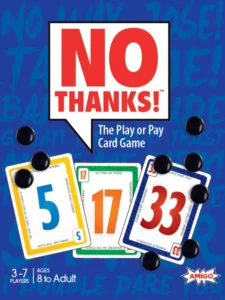No Thanks! Board Game Review

By MARK WILSON

Year Published: 2004
Players: 3-7
Playing Time: 20 minutes
No Thanks has a simple premise: you don’t want cards (numbered 3-35) since they equal negative points. To avoid them, you have a certain number of chips/discs/whatever that allow you to pay one to skip taking a card…until it comes back around to you and you have to pay again.
Eventually, you’ll run out of chips if you don’t take something, so figuring out when to cut your losses is important.
You’ll take whatever chips have been paid to avoid the card when you eventually take one. So the more chips you can acquire (i.e. future flexibility in avoiding more cards), the better.
I’ve been told that it owes the auctions structure to an earlier, more obscure game called Mogul. While I can’t confirm this tidbit, I’ve played Mogul and the auction DNA is indeed there. In that one, you’re bidding to stay in, though. A couple powerful actions exist in each round, and opting out means taking money to put toward future rounds instead of being able to take one of the actions. The same central tensions typify auction rounds, though.
Mogul maps the auction to a light strategy game involving company shares and buildings. No Thanks sheds this pretense and makes everything about the auctions and immediacy of the cards.
Where’s the Fun?
I left out a couple wrinkles of gameplay but nearly taught you the entire game above. Such is its simplicity, which is a boon for No Thanks.
The fun, then, comes in eking out the most from auctions. Nobody wants that 32, but it already has 8 chips on it. Will it survive around trip around the table and come back to you, allowing you to take it with 10+ chips on it instead of 8? Or should you take it now and ensure you have the safety net of those extra chips in future rounds?
At lower player counts, this calculus becomes subtly more cutthroat. You might decide to send that 32 around not just one more time, but twice. Or three times! Your opponents will groan and curse, but it’s the type of groan that’s hiding a wide smile.
And eventually someone will decide you don’t get to have any more fun of this type, and they’ll take the card that you expected to circle back around to you, laden with more juicy chips. You’ll smile sardonically, wishing you’d taken it a moment sooner into your scoring tableau. But then you realize that to spite you, your opponent had to take a damaging card. So did they really spite you? Or set you up for a win? The answer will vary, but it’s generally funny and interesting.
Value in Simplicity
I don’t consider it a fluke that No Thanks outpaced Mogul. Decades after its release, it’s still a well-known game in hobbyist circles and can be found in a variety of stores, not even those dedicated only to games.
The trick is in how direct it is.
I recently taught it to a group of five people (myself included). Even though I was the only one who’d played previously, we had about 40 minutes left in an event and I knew we’d be able to play at least once…and it turned out to be twice. I won the first game, owing to my knowledge of game flow. But they’d caught on by the second game, and I fared far worse.
So within 40 minutes, I’d taught four people, we played twice, they all enjoyed it enough to request the second game, and they’d absorbed the game’s basic ideas and strategies within that timeframe.
These qualities make it universal. Or timeless. Or broadly accessible. Or pick a similar adjective or phrase. There’s something refreshingly undemanding here; there’s little-to-no barrier between you and the fun.
Player Count and Luck
So far from this review you might think I love No Thanks. I do enjoy it, but it’s often a bit removed from those loftiest heights.
For one, some of the tensions I described above are often minimized at the game’s highest player counts. It’s at the game’s lowest player counts that I find the tensions highest. As a result, it’s listed as a 3-7 player game but in my mind it’s only good at about 3-5 players.
Second, I omitted one crucial rule earlier – that runs of cards (say, 23-24-25) only score for the lowest of those if you collect them all.
This lends some risk/reward to some decisions that can be deliciously agonizing. For example, if you have the 23 and the 25 comes up. Some cards go unused in a session, so there’s no guarantee you’ll get the 24. But if you do, you’re probably going to win.
But other times you’ll simply top-deck (i.e. draw for the next round) the exact card you need. A lot of these rounds are anti-climactic, and it’s also true to say that some entire games of No Thanks are determined not by savvy play in its auctions but by who gets the luckiest with card draws.
Balancing luck and strategy is the challenge of most games, and the presence of luck is not alone a damning factor. Indeed, No Thanks would be far worse with perfect information about upcoming card auctions, removing the luck factor. However, that doesn’t mean these elements are always perfectly balanced.
This, too, becomes more pronounced at higher player counts. At 6-7 players I often feel like I’m watching the game play itself, and whoever gets a couple lucky card draws is invariably destined to win.
The game is short and not meant to be taken too seriously, so this isn’t a damning criticism. But it’s a criticism nonetheless, because the gap between my best and worst sessions of No Thanks is considerable. Some of that can be mitigated by limiting the player count, at least, which is what saves it for me.
The Value of No Thanks
I mentioned those earlier teaching sessions, and that’s something like an ideal use-case for No Thanks. It was the perfect game for that moment. Not too demanding, I could teach it in under five minutes. But it also provided enough excitement and energy to propel us effortlessly through two sessions.
That was at the end of a long event. No one went home from that event with No Thanks top of mind as the new game they’d most enjoyed. But they all – I imagine – would be excited to see it hit the table again.
There’s value in that kind of reaction. And it’s one I’ve experienced a lot with No Thanks.
…
Like my content and want more? Check out my other reviews and game musings!
Read More From BTD
Recent Posts
Categories
- All (352)
- Announcements (4)
- Board Games (205)
- DMing (28)
- Game Design (16)
- Playing TTRPGs (22)
- Reviews (191)
- RPGs (142)
- Session Reports (91)
- Why Games Matter (9)